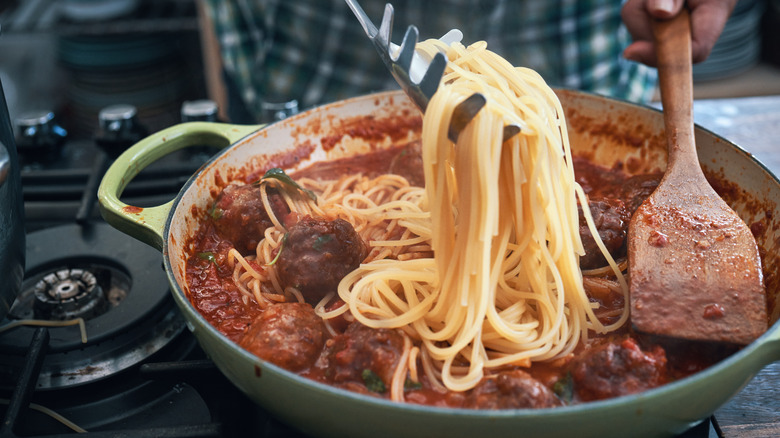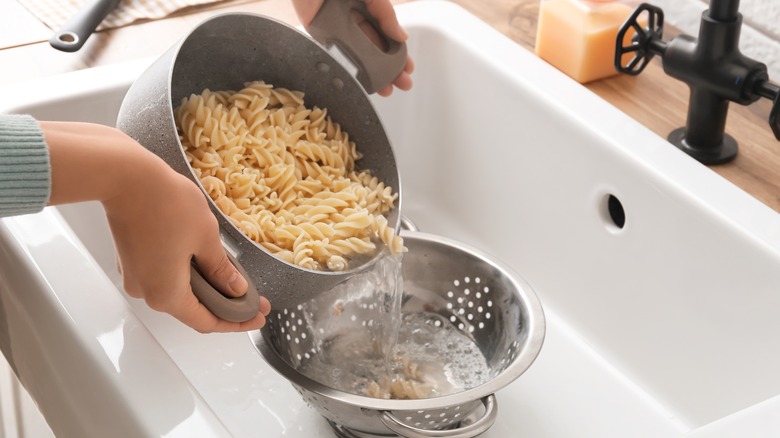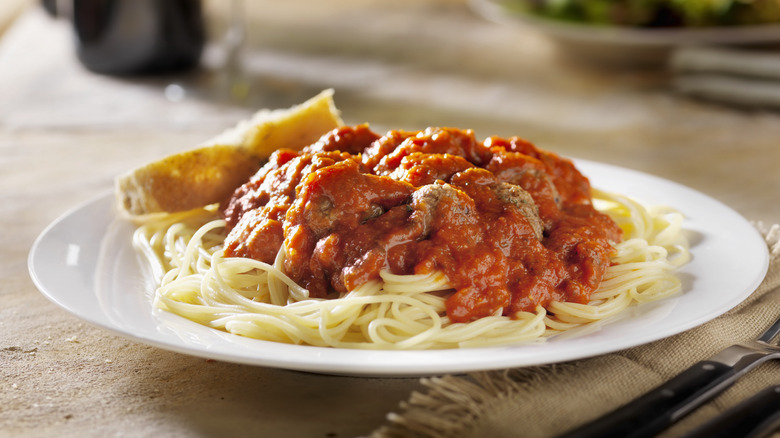The Right (And Definitely Wrong) Way To Combine Pasta With Sauce
Pasta and sauce: How difficult can it be to combine the two correctly? It turns out that there's actually a right and a wrong way to approach it. Let's start with the correct way: In short, you want to be mixing your pasta and sauce together in one pan to get an evenly balanced dish where every bite of pasta has the right amount of sauce attached.
But the truly correct way to do this involves a little more effort than just throwing the sauce and noodles together. Ideally, you want to cook the pasta in salted water, and when you drain it, save some pasta water (put a cup beneath the strainer to catch some). Then, you'll want to mix the pasta, sauce, and some of that reserved pasta water. It'd be smart to undercook the pasta by a minute or so, since it'll cook more when it's in the pan with the sauce and water.
There's not really an exact measurement for how much pasta water to add to the sauce, and sources vary on the best amount. But it doesn't hurt to be sparing: Start with around two tablespoons (1/8 cup) for each serving of pasta you've got in the pan, and add more as needed: You can always cook it off, although the more you do this, the higher the chances of overcooking your pasta.
It's all about the starch
The reason this is the "right" way to mix pasta and sauce is because the pasta water helps bind the noodles and the sauce together, as well as thickening the sauce. This might seem counterintuitive since you'd imagine that water might actually thin out a sauce. But pasta water is a different beast: It has a cloudy color, and the cause of that is all the starch from the pasta that has leached out into it. That starch is what helps bind the sauce and noodles together. (For this reason, you wouldn't want to try this sauce-mixing approach with regular tap water, as it would just thin the sauce and keep it from sticking to the noodles.) The salt in the pasta water can also add extra seasoning, too — but you'll want to be careful not to over-salt your sauce if you're planning to add this extra hit of salt at the end. It works particularly well for some creamier sauces like cacio e pepe or carbonara.
The starch also adds a silky texture to your sauce, thanks to the emulsification it causes, making for a rich final product where every piece of noodle should have a nice coating of sauce, making for a flavorful, well-mixed dish. Some cooks even recommend freezing your pasta water for other uses, like stews (again, that starch helps make for a rich sauce), or a nice, chewy pizza dough.
The definitely wrong way to sauce your pasta
It could be argued that any method that doesn't involve saving the pasta water and mixing it with the sauce and noodles is the "wrong" way to sauce pasta. But let's look at the one lazy method that's probably the most common. This involves cooking the pasta, draining it, and putting it straight in the bowl, and then pouring sauce on top (with the sauce having been heated in a separate pan).
The issue here is that you'll end up serving the pasta without really mixing the components together — even if you forget to save the pasta water, the pasta should be mixed up with the sauce before it gets served so that the sauce is spread evenly throughout the dish. This method can also lead to the pasta being doused in sauce, which goes against the general Italian convention of having the pasta covered in sauce, but not swimming in it. This method is made even worse if you happen to rinse the pasta after cooking it — this washes the starch off, which prevents the sauce from sticking, so you'll end up with a mass of sauce sliding off your teflon-pasta.


